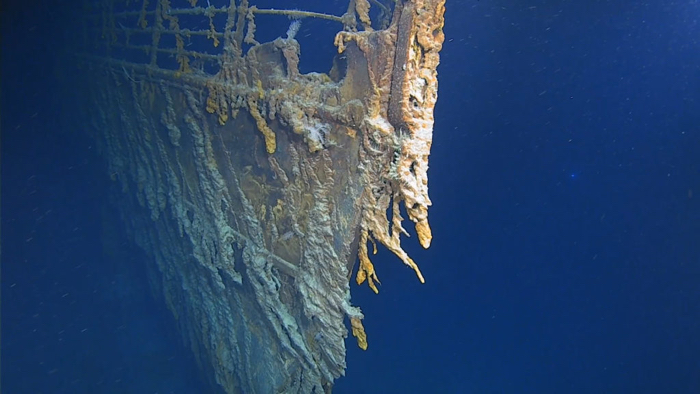The wreck of what may be the most famous and infamous sea vessel in history has been visited by humans for the first time in almost 15 years – revealing an incredible state of natural deterioration hidden deep within the Atlantic Ocean.
Rusting in silent isolation at a depth of 3,810 metres (about 12,500 feet) off the coast of Newfoundland in Canada, RMS Titanic is in a remarkable, one-way decline, according to a deep-ocean exploration team who conducted the first crewed dive to the wreck in 14 years.
Studying and filming the remains of the famous vessel for an upcoming documentary, experts and scientists who organised the expedition were taken aback by the sight of the decaying ship, which rests in two pieces on the seafloor hundreds of metres apart.
 (Atlantic Productions)
(Atlantic Productions)
"The most fascinating aspect was seeing how the Titanic is being consumed by the ocean and returning to its elemental form while providing refuge for a remarkably diverse number of animals," says Triton Submarines president Patrick Lahey.
The Triton Submarines exploration team conducted five dives to the wreck in early August with the depth submergence vehicle (DSV) Limiting Factor, filming the Titanic in 4K for the first time – and, if nature has its way, what may be one of the last times.
Exposed to sweeping eddies and sea currents on the sea floor, the Titanic is being slowly dismantled by salt corrosion and metal-eating bacteria.
"There are microbes on the shipwreck that are eating away the iron of the wreck itself, creating 'rusticle' structures, which is a much weaker form of the metal," expedition scientist and marine environment researcher Clare Fitzsimmons from Newcastle University in the UK told the BBC.
These rusticles progressively dissolve into ever finer fragments, eventually turning into a powder form that can be swept away by the current.
Because of this, previous estimates have suggested the entire wreck may disappear by 2030 or not long after, with the microbial devouring of the Titanic leaving nothing but a "rust stain on the bottom of the Atlantic".
BBC News - Titanic sub dive reveals parts are being lost to sea https://t.co/JjnFmU1nIk
— Atlantic Productions (@AtlanticProds) August 21, 2019
It's not yet clear whether the latest expedition will provide an update on those predictions, but the continuing decay of the ship was more than apparent to the team.
"The most shocking area of deterioration was the starboard side of the officer's quarters, where the captain's quarters were," Titanic historian Parks Stephenson explains in a statement.
"Captain's bath tub is a favourite image among the Titanic enthusiasts, and that's now gone. That whole deck hole on that side is collapsing taking with it the staterooms, and the deterioration is going to continue advancing."
While visiting the site, the expedition team laid a wreath to honour the memory of the more than 1,500 passengers and crew who perished in the tragic sinking disaster of 1912, the maiden voyage of what was at the time the largest vessel afloat.
In addition to the new high-resolution video, the expedition scientists surveyed the wreck using photogrammetry techniques, that in the future will enable 3D recreations of the Titanic in virtual and augmented reality.
"Titanic is returning to nature"
Parts of the wreck are now deteriorating rapidly
[Tap to expand] https://t.co/O4TUkYIZP4 pic.twitter.com/jL2MC2cijD
— BBC News (World) (@BBCWorld) August 21, 2019
For future generations, these artificial reconstructions will be the only way to witness the physical legacy of one of the world's deadliest marine disasters.
"The wreck itself is the only witness we've now got of the Titanic disaster," maritime historian Robert Blyth from the National Maritime Museum in the UK, who wasn't involved with the expedition, told the BBC.
"All of the survivors have now passed away, so I think it's important to use the wreck whilst the wreck still has something to say."
#Humans | https://sciencespies.com/humans/new-images-of-the-titanic-reveal-how-the-wreck-is-being-consumed-by-ocean-microbes/
No comments:
Post a Comment